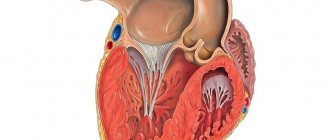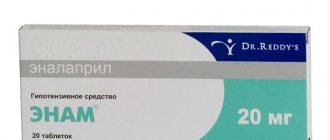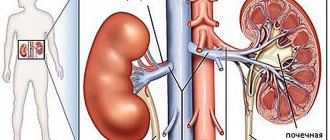Possibilities of combination therapy for arterial hypertension
As is known, effective antihypertensive therapy reduces the incidence of cerebral stroke by 42% and acute myocardial infarction by 14% in patients with hypertension.
Currently, there are a fairly large number of effective antihypertensive drugs - selective B1-blockers, A1-blockers, diuretics, calcium antagonists, ACE inhibitors, and in recent years - angiotensin II receptor blockers. Various clinical studies have shown that all of the listed classes of antihypertensive drugs reduce high blood pressure almost equally and can be used as first-line drugs (THOMS study), but in practice the situation is far from so clear. It was shown (Merand J., 1992) that among 11,613 patients with arterial hypertension, an adequate reduction in diastolic pressure was achieved only in 37% of cases, while the authors believe that one of the reasons for the unsatisfactory result was monotherapy, which did not allow blocking the various mechanisms responsible for rise in blood pressure. Thus, in observations of 1292 patients with hypertension (men) who received monotherapy for 1 year (Matterson BJ, 1995) with an initial diastolic pressure of 95-109 mm Hg. values of this indicator below 90 mm were obtained only in 40-60% of patients (depending on the drug used). The last circumstance is especially important and, apparently, can be explained by the fact that in response to taking one antihypertensive drug in patients with hypertension, the mechanisms that counteract the decrease in blood pressure are “launched” (or increased in activity). So, for example, when calcium antagonists are prescribed, the sympathoadrenal system is activated and fluid is retained in the body, and when diuretics are prescribed, the depletion of sodium “reserves” stimulates the renin-angiotensin system and activates the sympathoadrenal system. Long-term use of B-blockers leads to increased sympathetic tone of peripheral vessels (and to vasoconstriction); ACE inhibitors can increase (via a feedback mechanism) renin secretion. It is likely that this incomplete list will subsequently be supplemented by other mechanisms responsible for the occurrence of the “escape” effect. In this regard, the simultaneous use of two (and sometimes three) antihypertensive drugs with different mechanisms of action seems quite promising. Thus, this approach is justified by the following considerations:
- simultaneous use of drugs from two different pharmacological groups more actively reduces blood pressure due to the fact that there is an effect on various pathogenetic mechanisms of hypertension;
- the combined use of lower doses of two drugs acting on different regulatory systems will allow for better control of blood pressure, given the heterogeneity of the response of hypertensive patients to antihypertensive drugs;
- prescribing a second drug may weaken or balance the triggering of mechanisms to counteract the decrease in blood pressure that occurs when prescribing one drug;
- a sustained decrease in blood pressure can be achieved with smaller doses of two drugs than with monotherapy;
- smaller doses allow you to avoid dose-dependent side effects, the likelihood of which is higher with a larger dose of a particular drug (during monotherapy);
- the use of two drugs can to a greater extent prevent target organ damage (heart, kidneys) caused by hypertension;
- prescribing a second drug can to a certain extent reduce (and even completely eliminate) the undesirable effects caused by the first (even if quite effective) drug;
Given the presence of at least six groups of antihypertensive drugs, it is possible to create a fairly large number of combinations, however, in practice it is advisable to use only a few of them.
B-blocker in combination with a diuretic
It is known that a B-blocker, in addition to peripheral vasoconstriction (most pronounced in non-selective B-blockers), can increase sodium retention by the kidneys, and therefore its combination with a diuretic is completely justified. In this case, various types of combinations are possible: taking a diuretic daily or taking a diuretic 1-2 times a week. Preference should be given to thiazide diuretics (hydrochlorothiazide, chlorthalidone). Daily intake of a diuretic can range from 6.25-12.5 mg, but if a non-daily dose is prescribed, the dose is usually increased to 25 mg (1-2 times a week). These doses are to a certain extent approximate; in each specific case, the dose of the diuretic can be changed. Fixed doses of antihypertensive components are very convenient, the non-extended-release B-blocker pindolol (Wisken) at a dose of 10 mg was combined with the diuretic clopamide (5 mg) - the drug "Viskaldix", the selective B-blocker atenolol at a dose of 100 mg with chlorthalidone (25 mg) - drugs "tenoric" and "tenoretic".
Calcium antagonist in combination with a B-blocker
The hypotensive effect of calcium antagonists of all three generations is beyond doubt. However, peripheral vasodilation can cause quite pronounced activation of the sympathetic nervous system (which in itself is a pressor factor) and reflex tachycardia, which is poorly tolerated by patients. In this situation, the addition of a B-blocker not only has an additional hypotensive effect (which may allow the dose of the calcium antagonist to be reduced), but also has a “corrective” effect, reducing (and completely eliminating) tachycardia. The addition of a B-blocker is especially appropriate for drugs such as nifedipine and felodipine, less often for isradipine and very rarely for amlodipine. Currently, the most well studied fixed combination of felodipine (5 or 10 mg) and the cardioselective B-blocker metoprolol (50 or 100 mg) is the drug Logimax. This combination has been shown to be more effective than each of its components separately. A less well-known combination of nifedipine (20 mg) and atenolol (50 mg) is the drug Niften. At the same time, isoptin should not be combined with a B-blocker (due to the pronounced synergism of action).
Calcium antagonist in combination with a diuretic
As you know, one of the side effects of calcium antagonists (of almost all generations) is swelling of the ankles and legs (due to vasodilation?). The addition of diuretics (thiazides) helps to get rid of this undesirable phenomenon, while the doses of diuretics are not very large.
ACE inhibitors in combination with a diuretic
ACE inhibitors themselves are very effective in most patients with hypertension, but the addition of a diuretic significantly enhances the hypotensive effect. In addition, such a combination is justified in patients in whom an ACE inhibitor reduces blood pressure well, but causes side effects such as cough (which requires a dose reduction). Finally, this combination is especially effective in older people, especially if hypertension is combined with symptoms of heart failure. In Russia, such combinations as “korenitek” (enalapril 10 mg and hydrochlorothiazide 25 mg), “enap-N” (enalapril and hydrochlorothiazide in the same dosages), “caposide” (captopril 50 mg and hydrochlorothiazide 12.5 mg) have become widespread ). The average dose is 1 2 tablets 1 time per day (regardless of meals).
ACE inhibitor in combination with a calcium antagonist
This combination is fundamentally new. It has been shown that it produces significantly fewer side effects than each of its components separately. In 1994 In Europe, the Knoll company released the drug Tarka, which is a combination of a new generation ACEI - trandolapril (at a dose of 1 or 2 mg) and verapamil-SR (retarded form) at a dose of 180 mg.
Antigen II receptor blockers and diuretic
A fundamentally new class of drugs - angiotensin II receptor blockers (AT-II) - "Cozaar" (losarten), "Diovan" (valsartan) showed high antihypertensive activity comparable to ACE inhibitors. However, probably the desire to obtain a stronger effect led to the creation of a combination drug, Gizaar (losartan at a dose of 50 mg and hydrochlorothiazide at a dose of 12.5 mg). The first experience of its use shows undoubted advantages over monotherapy with losartan alone.
The use of combination therapy using drugs with fixed doses (two drugs in one tablet) has a number of advantages: for the patient - ease of dosing, convenience of a single dose; for the doctor there are also a number of positive aspects in the form of confidence in the patient’s desire to follow the prescribed recommendations (compliance), the ability to manage with smaller doses of the drugs included in the tablet, and therefore a lower likelihood of dose-dependent side effects.
Thus, at the present stage of views on the treatment of hypertension, the principle of combination therapy should be recognized as a priority, although this does not mean that in a certain category of patients monotherapy is impossible, in particular in young people in the absence of target organ damage and good tolerability prescribed drugs.
Treatment of arterial hypertension: combination of drugs and combination drugs
About the article
28859
0
Regular issues of "RMZh" No. 10 dated 05/05/2010 p. 708
Category: Cardiology
Authors: Vertkin A.L. 1, Topolyansky A.V. 2 1 FSBEI HE MGMSU im. A.I. Evdokimov Ministry of Health of Russia, Moscow, Russia 2 State Budgetary Educational Institution of Higher Professional Education “MGMSU named after. A.I. Evdokimov" Ministry of Health of the Russian Federation, Moscow
For quotation:
Vertkin A.L., Topolyansky A.V. Treatment of arterial hypertension: combination of drugs and combination drugs. RMJ. 2010;10:708.
When selecting antihypertensive therapy, from the very first steps the doctor has to decide the problem: is it possible in this case to get by with one drug (monotherapy) or the use of the most effective drug will be insufficient. It is possible to achieve the target blood pressure level using monotherapy with any antihypertensive drug in less than half of the patients; Combination therapy was required in 45% of patients in the SHEP (Systolic Hypertension in the Elderly Program) trial, 62% in the ALLHAT (Antihypertensive and Lipid–Lowering treatment to prevent Heart Attack Trial), 63% in the HOT (Hypertension Optimal Treatment) trial, 80 % in the INVEST study (Verapamil SR/Trandolapril Study), in the LIFE study (Losartan Intervention For reduction in hypertension study) – 92%.
According to the Recommendations of the Russian Medical Society on Arterial Hypertension (RMSHA) and the All-Russian Scientific Society of Cardiology (VNOK) in 2008, treatment of arterial hypertension can begin with low-dose combination therapy, followed by increasing the amount and/or doses of the drug if necessary, and full-dose combination therapy can be prescribed at the start of treatment for patients with blood pressure ≥ 160/100 mmHg. with a high and very high risk of cardiovascular complications. At the same time, excessive therapeutic activity often results in so-called polypharmacy, when several (sometimes many!) drugs are simultaneously prescribed without sufficient justification for the use of each of them; Therefore, when prescribing combination therapy, drug interactions should be assessed from the standpoint of effectiveness and safety, as well as patient comfort and cost of course treatment. According to domestic recommendations, drugs used in combination must meet a number of requirements: – have a complementary effect; – achieve improved results when used together; – drugs must have similar pharmacodynamic and pharmacokinetic parameters, which is especially important for fixed combinations. All the advantages of combination therapy are manifested in the case of a rational combination of antihypertensive drugs; if the combination is not absolutely recommended, but is not prohibited, then it is considered possible; if, when used together, drugs do not potentiate their hypotensive effect or side effects increase, the combination is considered irrational (Table 1). It should be noted that, in contrast to the European recommendations (EOAG/EOC, 2007), the Russian recommendations do not exclude the use of low doses of thiazide diuretics (6.25 mg) in combination with highly selective beta-blockers or those with vasodilating properties (in such a combination there are negative metabolic effects drugs should be minimal), as well as a combination of b- and a-blockers (in particular, in men with arterial hypertension and benign prostatic hyperplasia). The combination of a diuretic and a calcium antagonist raises certain doubts: according to Boger-Megiddo I., et al. (2010), it is associated with an increased risk of myocardial infarction compared to combinations of a diuretic and a beta-blocker and a diuretic and an ACE inhibitor. In recent years, the combination of ACE inhibitors and calcium antagonists has attracted increasing interest. This was greatly facilitated by the publication of the results of the Anglo-Scandinavian Cardiac Outcomes Trial-Blood PressureLowering Arm (ASCOT-BPLA) study on the comparative use of a combination of amlodipine and perindopril, on the one hand, and a combination of atenolol and bendroflumethiazide, on the other. The severity of the decrease in blood pressure, the incidence of non-fatal myocardial infarction, including painless forms, as well as death from coronary artery disease in the two groups of patients did not differ significantly, however, in the amlodipine ± perindopril group compared with the atenolol ± bendroflumethiazide group, a decrease in the risk of developing non-fatal myocardial infarction was found by 13 %, all coronary events and procedures by 16%, overall mortality by 11%, cardiovascular mortality by 24%, fatal and non-fatal strokes by 23%. Efficacy of fixed combinations of a calcium antagonist with an ACE inhibitor (amlodipine at a dose of 5–10 mg + benazepril at a dose of 10–20 mg) and an ACE inhibitor with a thiazide diuretic (benazepril at a dose of 10–20 mg + hydrochlorothiazide at a dose of 12.5–25 mg) was compared in The Avoiding Cardiovascular Events through Combination Therapy in Patients Living with Systolic Hypertension (ACCOPLISH) study, which lasted 5 years and included 11,400 hypertensive patients with systolic blood pressure >160 mmHg. over the age of 55 years, obese, with cardiovascular or renal disease or target organ damage; 60% of them suffered from type 2 diabetes. When taking a combination of a calcium antagonist with an ACE inhibitor, a slightly more pronounced hypotensive effect was noted, and cardiovascular morbidity and mortality were significantly lower by 20%. The efficacy and safety of a fixed combination of amlodipine and lisinopril compared with the isolated use of each component was assessed in the Hungarian multicenter study (HAMLET), conducted in Hungary. The randomized, placebo-controlled (at baseline), double-blind study included 195 patients with untreated or poorly controlled hypertension (BP 140–179/90–99 mmHg). It has been shown that a fixed combination of amlodipine with lisinopril can more significantly reduce the levels of systolic and diastolic blood pressure with a lower incidence of side effects. The number of patients who achieved target blood pressure (below 140/90 mmHg) was 90% in the combination therapy group, 79% in the amlodipine group and 75% in the lisinopril group. From the point of view of ensuring the comfort of treatment, instead of several individual drugs, it is sometimes advisable to use combination drugs - dosage forms containing two or more active pharmacological substances. The advantage of combination drugs compared to combination therapy with several drugs is psychological and social comfort (it is much more convenient to take one tablet or take one inhalation than several). Sometimes this turns out to be more cost-effective, since the cost of combination drugs is usually less than the cost of components prescribed separately. The disadvantages of combined drugs are due to the “fixed” ratio of the drugs included in them and often the non-synchronism of the maximums of their effects (for example, in Korenitek, the diuretic effect is ahead of the vasodilator). Features of the use of combined agents: – indicated for patients who really need combination therapy; – should be used only during the “typical” course of the disease (since the pharmacologically active substances are included in the combination drug in the most common ratio, calculated for the “typical” course of the disease); – are more often used at the stage of maintenance therapy (rather than at the stage of selecting drug treatment), since the fixed nature of the ingredients excludes the possibility of promptly changing doses and correcting their ratio; – are the drugs of choice for “undisciplined” patients who require lifelong treatment. Examples of combined antihypertensive drugs are presented in Table 2. In recent years, a new combination drug Equator (Gedeon Richter, Hungary), which is a combination of 10 mg of lisinopril and 5 mg of amlodipine, has entered clinical practice. The prolonged action of the drugs included in its composition ensures 24-hour blood pressure control with a single dose of the drug. The pronounced hypotensive effect of Equator is due to the potentiation of the effect of its components: lisinopril reduces the activity of the renin-angiotensin and sympatho-adrenal systems, the activation of which reduces the effectiveness of amlodipine, and the negative sodium balance caused by amlodipine enhances the hypotensive effect of lisinopril. The likelihood of developing side effects is reduced, namely: - swelling of the legs, which occurs while taking dihydropyridines due to dilatation of precapillary arterioles and an increase in intracapillary hydrostatic pressure (ACE inhibitors, causing dilatation of postcapillary venules, reduce hydrostatic pressure in the capillaries); – tachycardia, developing as a reaction to vasodilation (ACE inhibitors, by suppressing the formation of angiotensin II, reduce the release of norepinephrine and reduce central sympathetic activity). The combined use of an ACE inhibitor and a calcium antagonist leads to a decrease in glomerular pressure and albumin excretion; the renoprotective effect may be beneficial in patients with diabetic nephropathy. The metabolically neutral components of the drug allow us to recommend its use in metabolic syndrome. All this allows us to consider the use of the combined drug Equator promising for arterial hypertension, including in patients with left ventricular myocardial hypertrophy, coronary artery disease, atherosclerosis of the carotid and peripheral arteries, metabolic syndrome and diabetes mellitus, chronic renal failure, etc.
References 1. Boger–Megiddo I., Heckbert SR, Weiss NS et al. Myocardial infarction and stroke associated with diuretic based two drug antihypertensive regimens: population based case–control study. BMJ. 2010, 25; 340:c103. 2. Dahlof B., Sever PS, Poulter NR et al. Prevention of cardiovascular events with an attihypertensive regimen of amlodipine adding perindopril as required versus atenolol adding bendroflumethiazide as required, in the Anglo–Scandinavian Cardiac Outcomes Trial–Blood Pressure Lowering Arm (ASCOT–BPLA): A multicentre randomized controlled trial. Lancet. 2005; 366:895–906. 3. Jamerson K, Weber MA, Bakris GL et al.; ACCOMPLISH Trial Investigators. Benazepril plus amlodipine or hydrochlorothiazide for hypertension in high-risk patients. N Engl J Med. 2008; 359(23): 2417–2428. 4. Farsang C. A HAMLET Vizsgalok neveben. A lisinopril es az amlodipin kombinaciojanak elonyei az antihypertensiv terapiaban. A Hypertoniaban adott AMlodipin 5 mg es Lisinopril 10mg tablettak hatekonysaganak es toleralhatosaganak osszehasonlito vizsgalata kulon es Egyutt alkalmazott Terapiakent (HAMLET). Multicentrikus vizsgalat eredmenyei. Hypertonia es nephrologia, 2004; 8(2):72–8.
Content is licensed under a Creative Commons Attribution 4.0 International License.
Share the article on social networks
Recommend the article to your colleagues








